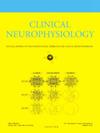颈椎经皮脊髓直流电刺激对脊髓兴奋性的影响
IF 3.7
3区 医学
Q1 CLINICAL NEUROLOGY
引用次数: 0
摘要
目的 通过神经生理学方法研究经皮脊髓直流电刺激(tsDCS)对脊髓兴奋性的影响。方法 在一项假对照随机实验中,使用各种神经生理学技术评估脊髓运动神经元的兴奋性,其中包括提供 2 mA tsDCS 和测试四种不同的单体。结果 在测试的四种tsDCS组合中,阳极位于第7颈椎棘突、阴极位于声门的组合最有希望。通过这种配置,在tsDCS期间观察到手部肌肉对对侧手部运动区TMS的运动反应明显增强(p<0.00001),6分钟后达到高峰。tsDCS停止后几分钟内,这种促进作用迅速减弱。意义tsDCS后兴奋性增强的现象表明,它有可能应用于影响手部运动功能的部分皮质脊髓纤维损伤患者。本文章由计算机程序翻译,如有差异,请以英文原文为准。
Effects of cervical transcutaneous spinal direct current stimulation on spinal excitability
Objective
To investigate the effects of transcutaneous spinal direct current stimulation (tsDCS) on spinal cord excitability using neurophysiological methods.
Methods
Spinal cord motoneuron excitability was assessed using various neurophysiological techniques in a sham-controlled randomized experiment, which involved delivering 2 mA tsDCS and testing four different montages. Transcranial magnetic stimulation (TMS), F-waves to supramaximal ulnar nerve stimulation and somatosensory evoked potentials to upper limb nerves stimulation were measured in the participants with the electrode configuration that yielded the greatest effect, for a total of about 18 min. 18 young volunteers were recruited.
Results
Among the tested ones, the most promising tsDCS montage was the one with the anode placed on the 7th cervical spinous process and the cathode on the glottis. With this configuration, a significant enhancement of motor responses in the hand muscles to TMS of the contralateral hand motor area was observed during tsDCS (), reaching a plateau after 6 min. This facilitation rapidly declined within a few minutes after the tsDCS was stopped.
Conclusion
Results of the different techniques suggest a possible contribution to facilitatory neuromodulation of the motoneurons at the cervical spine level.
Significance
The occurrence of enhanced excitability after tsDCS suggests potential application in individuals with partial corticospinal fiber impairment affecting hand motor function.
求助全文
通过发布文献求助,成功后即可免费获取论文全文。
去求助
来源期刊

Clinical Neurophysiology
医学-临床神经学
CiteScore
8.70
自引率
6.40%
发文量
932
审稿时长
59 days
期刊介绍:
As of January 1999, The journal Electroencephalography and Clinical Neurophysiology, and its two sections Electromyography and Motor Control and Evoked Potentials have amalgamated to become this journal - Clinical Neurophysiology.
Clinical Neurophysiology is the official journal of the International Federation of Clinical Neurophysiology, the Brazilian Society of Clinical Neurophysiology, the Czech Society of Clinical Neurophysiology, the Italian Clinical Neurophysiology Society and the International Society of Intraoperative Neurophysiology.The journal is dedicated to fostering research and disseminating information on all aspects of both normal and abnormal functioning of the nervous system. The key aim of the publication is to disseminate scholarly reports on the pathophysiology underlying diseases of the central and peripheral nervous system of human patients. Clinical trials that use neurophysiological measures to document change are encouraged, as are manuscripts reporting data on integrated neuroimaging of central nervous function including, but not limited to, functional MRI, MEG, EEG, PET and other neuroimaging modalities.
 求助内容:
求助内容: 应助结果提醒方式:
应助结果提醒方式:


